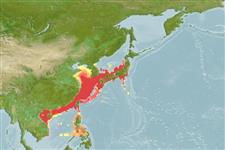Common names from other countries
Пластиножаберные (акулы и скаты) (sharks and rays) >
Carcharhiniformes (Ground sharks) >
Triakidae (Houndsharks) > Triakinae
Etymology: Mustelus: Latin for weasel, an ancient name for sharks, possibly referring to the pointed snouts, swift movements and/or rapacious feeding behavior of smaller predatory sharks [strictly not tautonymous with Squalus mustelus Linnaeus 1758 since type was designated by the ICZN]. (See ETYFish); griseus: Medieval Latin for gray, referring to gray or gray-brown color. (See ETYFish).
Environment: milieu / climate zone / depth range / distribution range
экология
морской демерсальный; пределы глубины 5 - 300 m (Ref. 104830), usually 51 - ? m (Ref. 104830). Tropical; 41°N - 11°N, 105°E - 142°E
Northwest Pacific: Japan, Korea, China, Taiwan, and Viet Nam (Ref. 244). Possibly occurring in the Philippines (Ref. 13563).
Length at first maturity / Size / Вес / Возраст
Maturity: Lm 72.0, range 70 - 74 cm
Max length : 87.0 cm TL самец/пол неопределен; (Ref. 244); 101.0 cm TL (female); наибольший возраст (опубликованны данные): 9 годы (Ref. 6983)
An inshore bottom-dwelling shark found down to at least 51 m (Ref. 244); also dwells in semi-enclosed sea areas with sand bottom (Ref. 11230). Probably feeds on benthic invertebrates, especially crustaceans (Ref. 13563). Viviparous, with a yolk-sac placenta (Ref. 244).
Viviparous with a yolk-sac placenta. Produces 5 to 16 young per litter, with larger adults having larger litters of young. Gestation period is 10 months, birth occurring in April and May. Size at birth about 28 cm (Ref. 244).
Compagno, L.J.V., 1984. FAO Species Catalogue. Vol. 4. Sharks of the world. An annotated and illustrated catalogue of shark species known to date. Part 2 - Carcharhiniformes. FAO Fish. Synop. 125(4/2):251-655. Rome: FAO. (Ref. 244)
Статус Красного Списка МСОП (Ref. 130435)
CITES (Ref. 128078)
Not Evaluated
Использование человеком
рыболовство: коммерческий
дополнительная информация
инструменты
Специальные отчеты
Скачать в формате XML
ресурсы в Интернет
Estimates based on models
Preferred temperature (Ref.
115969): 11.1 - 23.2, mean 18.5 (based on 212 cells).
Phylogenetic diversity index (Ref.
82804): PD
50 = 0.5000 [Uniqueness, from 0.5 = low to 2.0 = high].
Bayesian length-weight: a=0.00224 (0.00105 - 0.00478), b=3.14 (2.97 - 3.31), in cm Total Length, based on LWR estimates for this Genus-body shape (Ref.
93245).
Trophic level (Ref.
69278): 3.5 ±0.4 se; based on diet studies.
устойчивость к внешним воздействиям (Ref.
120179): очень низкий, минимальное время удвоения популяции более 14 лет (tm=5.3-6.5; tmax=9; Fec=5).
Fishing Vulnerability (Ref.
59153): High vulnerability (59 of 100).
